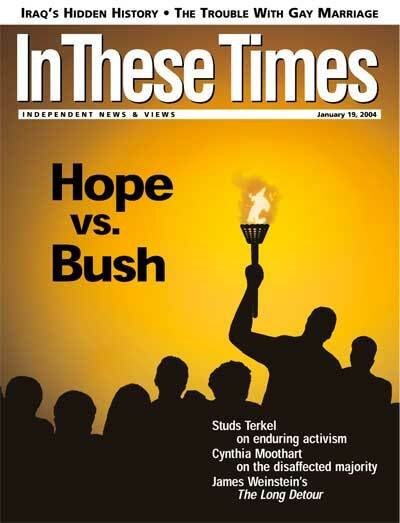For the better part of a decade, there has been a steady stream of books written about Bill Clinton, the voracious, talented, perplexing and deeply flawed manchild of American politics. Just last year political snake oil salesman Dick Morris published his abysmal bow to his new employers at FOX News, Off With Their Heads, in which he tears apart Clinton, claiming, among other things, that if Clinton had only listened to his draconian policy advice, we could have avoided the 9/11 attacks. More recently, Sidney Blumenthal’s book-length apologia for Clinton and his personal failings, The Clinton Wars, briefly reminded us of the nations’ dark night of the soul known as the Starr Commission. Even respected political theorist Benjamin Barber managed to allow himself to get sucked into the Clinton personality vortex when in 2001 he published The Truth of Power about his frustrating time as an unofficial advisor to a constantly waffling president.
Despite the volume of punditry on the Clinton legacy, however, little of substance has been written about his economic policies, as publishers surely know that Monica moves more units than a study of banking regulation reform. Joseph Stiglitz is a different kind of politico, though, and his new book The Roaring Nineties is a sober look at the economic policies of the Clinton administration from a man who served as chairman of Clinton’s Council of Economic Advisors from ’93 to ’97, before moving on to become senior vice president and chief economist of the World Bank and winning a Nobel Prize in Economics in 2001. Perhaps because he isn’t a pure political animal like Morris or Blumenthal, he manages to stay away from the overtly partisan sniping that has become giddy bloodsport in the press. Like his celebrated Globalization and its Discontents, published in 2002, Stiglitz uses the book to critique the opaque relationship between politics and economics from the viewpoint of someone who took part in the political battles over the finer points of their overlap.
The time when it looked as though the United States had defeated the business cycle seems like a lifetime ago. But under the exuberant surface was a seething inequality and hypocrisy, claims Stiglitz, epitomized in the way the Clinton administration practiced one policy at home while exporting the opposite policy abroad. Under the heavy-handed tutelage of the IMF and World Bank, struggling economies were forced to adopt strict anti-inflation policies in return for financial aid, which among other factors, helped cause the Asian economic crash of the late ’90s while bankrupting other weak economies.
The fact that Stiglitz won his Nobel Prize for his work on asymmetries of information plays no small part in his analysis. The theory rests upon the supposition that in any transaction one party will always be privy to information that the other is not, and will exploit this weakness for their own gain. This is exactly what the IMF does, Stiglitz claims, when imposing austerity measures on broken economies. It also goes a long way in explaining how Enron and other companies managed to hide their accounting games for so long. In fact, he sees Enron as emblematic of the decade as a whole: “The story of Enron was the story of the nineties—the excesses of deregulation, accounting chicanery, corporate greed, bank complicity. So too, as globalization embraced the world, Enron embraced globalization, and Enron showed the world the darker side of globalization.” (p. 270)
The primary problem in the ’90s was an overeager reliance on the market to solve market inequality, leading to a rash of ill-advised deregulation schemes, particularly in the telecom sector, which led directly to the Enron, Worldcom, Adelphia and Anderson debacles. “Deregulation in telecom unleashed a Gold Rush;” he says, adding that “deregulation in banking allowed the Rush to go out of control” More than anything else, however, Stiglitz singles out Finance as a major culprit, and once the Clinton administration stepped back and allowed the financiers to run the show, it was only a matter of time before the walls came tumbling down. Stiglitz contends that “What happened in the Roaring Nineties was that a set of longstanding checks and balances—a balance between Wall Street, Main Street and labor, between Old Industry, New Technology, government and the market—was upset., in some essential ways, by the new ascendancy of Finance.” In other words, what Wall Street wanted, Wall Street got.
But how did finance reach such untouchable heights? Stiglitz claims that its roots lie in the savings and loan crisis of the 1980s. At the time, high interest rates had pretty much bankrupted many S&Ls, and president Regan, anxious about bursting the real estate bubble, allowed new (and dubious) accounting standards to be used while urging the banks to use real estate holdings as a tax shelter. The banks, taking advantage of this, poured money into risky investments that went belly up—which led Bush I to partially re-regulate the industry in an effort to bring the banks’ balance sheets back from oblivion and try and drag the American economy out of recession. Obviously, he didn’t get this done fast enough, which went a long way in paving the way to a Clinton presidency in 1992. Stiglitz credits Clinton’s obsession with deficit reduction during his first year in office with the eventual recapitalization of American banks. Well, that and a couple lucky breaks.
Since the late ’80s, the Fed graced banks with the opportunity to treat long-term government bonds as risk-free. If interest rates had risen, it’s likely that another banking meltdown would have occurred, making Clinton a one and out president. But a perfect storm of falling interest rates and skyrocketing long-term bond value occurred, filling the coffers of banks like in their ’80s heyday, setting off the wave of “irrational exuberance” and investment that was the hallmark of the ’90s. But even this newfound capitalization could have been derailed, or at least be kept in check, if not for another mistake that sent the decade off on its wild, and ill-fated ride: The Fed, unconvinced about the strength of the recovery, refused to raise interest rates, thereby allowing growth, and bad investments, to continue unabated. Another factor that helped the economy was that decades of government-sponsored research and development in the high-tech sector finally coalesced in the ’90s, which helped lead the charge into that giddy decade of dashed hopes. All this money, excitement and investment led the Clinton administration to follow the markets chief cheerleader, Robert Rubin, to let finance call the shots, or as Stiglitz says: “In the end, we allowed the markets to become pivotal in determining not just the government’s fiscal policy—making deficit reduction the first priority—but also the government’s monetary policy. The Fed, under cover of its vaunted independence, was largely driven by the views of the financial markets; it gave their inflation-related worries far more weight than labor’s unemployment-related worries.”
A large part of the problem, he contends, was the governing philosophy of the New Democrats, and the way Clinton moved to the right in order to secure reelection instead of sticking to his progressive guns. By doing this, Clinton led the Democratic Party away from any grand vision for the country and jettisoned his social agenda in favor of acting as a steward for the economy.
In the final pages, Stiglitz can’t resist from launching a scathing indictment of the Bush administration’s recent disastrous economic decisions. While Stiglitz admits that the economic downturn was already under way when Bush took office, he makes a convincing case that Bush dropped the ball in every aspect of managing the recovery. Cutting taxes for the wealthy, continuing the deregulation free for all, doing away with the estate and gift taxes, and bungling foreign trade practices all worsened the downturn, he claims. But just when the book appears to have reached a satisfyingly descriptive conclusion, Stiglitz changes gears and offers a prescriptive “New Democratic Idealism” theory, which is “a way between socialism and its overtly intrusive government and the Reagan-Thatcherite minimalist governments of the right.” Now, this isn’t your fathers’ Clintonian “Third Way.” Instead, it’s a fairly common-sense proposal to reconfirm government’s role in managing the economy, while leaving the market enough room to make its own decisions. The American economy is strong not because the government stays out of the market, Stiglitz claims, but because the government takes an active role in it. If we are to encourage growth, protect consumers, ensure social justice and continue our lead in technological innovation, we must remember that both democracy and capitalism require work, and that for both to function properly, corporations must be accountable citizens, the government must operate with long term goals in mind, and the citizenry must act as a watchdog to ensure that the interplay between public and private remains strong.
Despite the volume of punditry on the Clinton legacy, however, little of substance has been written about his economic policies, as publishers surely know that Monica moves more units than a study of banking regulation reform. Joseph Stiglitz is a different kind of politico, though, and his new book The Roaring Nineties is a sober look at the economic policies of the Clinton administration from a man who served as chairman of Clinton’s Council of Economic Advisors from ’93 to ’97, before moving on to become senior vice president and chief economist of the World Bank and winning a Nobel Prize in Economics in 2001. Perhaps because he isn’t a pure political animal like Morris or Blumenthal, he manages to stay away from the overtly partisan sniping that has become giddy bloodsport in the press. Like his celebrated Globalization and its Discontents, published in 2002, Stiglitz uses the book to critique the opaque relationship between politics and economics from the viewpoint of someone who took part in the political battles over the finer points of their overlap.
The time when it looked as though the United States had defeated the business cycle seems like a lifetime ago. But under the exuberant surface was a seething inequality and hypocrisy, claims Stiglitz, epitomized in the way the Clinton administration practiced one policy at home while exporting the opposite policy abroad. Under the heavy-handed tutelage of the IMF and World Bank, struggling economies were forced to adopt strict anti-inflation policies in return for financial aid, which among other factors, helped cause the Asian economic crash of the late ’90s while bankrupting other weak economies.
The fact that Stiglitz won his Nobel Prize for his work on asymmetries of information plays no small part in his analysis. The theory rests upon the supposition that in any transaction one party will always be privy to information that the other is not, and will exploit this weakness for their own gain. This is exactly what the IMF does, Stiglitz claims, when imposing austerity measures on broken economies. It also goes a long way in explaining how Enron and other companies managed to hide their accounting games for so long. In fact, he sees Enron as emblematic of the decade as a whole: “The story of Enron was the story of the nineties—the excesses of deregulation, accounting chicanery, corporate greed, bank complicity. So too, as globalization embraced the world, Enron embraced globalization, and Enron showed the world the darker side of globalization.” (p. 270)
The primary problem in the ’90s was an overeager reliance on the market to solve market inequality, leading to a rash of ill-advised deregulation schemes, particularly in the telecom sector, which led directly to the Enron, Worldcom, Adelphia and Anderson debacles. “Deregulation in telecom unleashed a Gold Rush;” he says, adding that “deregulation in banking allowed the Rush to go out of control” More than anything else, however, Stiglitz singles out Finance as a major culprit, and once the Clinton administration stepped back and allowed the financiers to run the show, it was only a matter of time before the walls came tumbling down. Stiglitz contends that “What happened in the Roaring Nineties was that a set of longstanding checks and balances—a balance between Wall Street, Main Street and labor, between Old Industry, New Technology, government and the market—was upset., in some essential ways, by the new ascendancy of Finance.” In other words, what Wall Street wanted, Wall Street got.
But how did finance reach such untouchable heights? Stiglitz claims that its roots lie in the savings and loan crisis of the 1980s. At the time, high interest rates had pretty much bankrupted many S&Ls, and president Regan, anxious about bursting the real estate bubble, allowed new (and dubious) accounting standards to be used while urging the banks to use real estate holdings as a tax shelter. The banks, taking advantage of this, poured money into risky investments that went belly up—which led Bush I to partially re-regulate the industry in an effort to bring the banks’ balance sheets back from oblivion and try and drag the American economy out of recession. Obviously, he didn’t get this done fast enough, which went a long way in paving the way to a Clinton presidency in 1992. Stiglitz credits Clinton’s obsession with deficit reduction during his first year in office with the eventual recapitalization of American banks. Well, that and a couple lucky breaks.
Since the late ’80s, the Fed graced banks with the opportunity to treat long-term government bonds as risk-free. If interest rates had risen, it’s likely that another banking meltdown would have occurred, making Clinton a one and out president. But a perfect storm of falling interest rates and skyrocketing long-term bond value occurred, filling the coffers of banks like in their ’80s heyday, setting off the wave of “irrational exuberance” and investment that was the hallmark of the ’90s. But even this newfound capitalization could have been derailed, or at least be kept in check, if not for another mistake that sent the decade off on its wild, and ill-fated ride: The Fed, unconvinced about the strength of the recovery, refused to raise interest rates, thereby allowing growth, and bad investments, to continue unabated. Another factor that helped the economy was that decades of government-sponsored research and development in the high-tech sector finally coalesced in the ’90s, which helped lead the charge into that giddy decade of dashed hopes. All this money, excitement and investment led the Clinton administration to follow the markets chief cheerleader, Robert Rubin, to let finance call the shots, or as Stiglitz says: “In the end, we allowed the markets to become pivotal in determining not just the government’s fiscal policy—making deficit reduction the first priority—but also the government’s monetary policy. The Fed, under cover of its vaunted independence, was largely driven by the views of the financial markets; it gave their inflation-related worries far more weight than labor’s unemployment-related worries.”
A large part of the problem, he contends, was the governing philosophy of the New Democrats, and the way Clinton moved to the right in order to secure reelection instead of sticking to his progressive guns. By doing this, Clinton led the Democratic Party away from any grand vision for the country and jettisoned his social agenda in favor of acting as a steward for the economy.
In the final pages, Stiglitz can’t resist from launching a scathing indictment of the Bush administration’s recent disastrous economic decisions. While Stiglitz admits that the economic downturn was already under way when Bush took office, he makes a convincing case that Bush dropped the ball in every aspect of managing the recovery. Cutting taxes for the wealthy, continuing the deregulation free for all, doing away with the estate and gift taxes, and bungling foreign trade practices all worsened the downturn, he claims. But just when the book appears to have reached a satisfyingly descriptive conclusion, Stiglitz changes gears and offers a prescriptive “New Democratic Idealism” theory, which is “a way between socialism and its overtly intrusive government and the Reagan-Thatcherite minimalist governments of the right.” Now, this isn’t your fathers’ Clintonian “Third Way.” Instead, it’s a fairly common-sense proposal to reconfirm government’s role in managing the economy, while leaving the market enough room to make its own decisions. The American economy is strong not because the government stays out of the market, Stiglitz claims, but because the government takes an active role in it. If we are to encourage growth, protect consumers, ensure social justice and continue our lead in technological innovation, we must remember that both democracy and capitalism require work, and that for both to function properly, corporations must be accountable citizens, the government must operate with long term goals in mind, and the citizenry must act as a watchdog to ensure that the interplay between public and private remains strong.
Paul McLeary regularly reviews books for In These Times. For more go to his his Web site.








